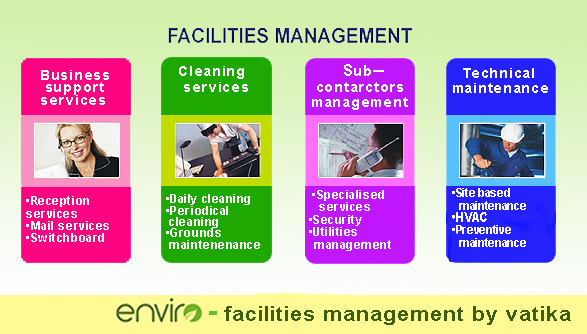The Essential Overview to Center Administration: Techniques for Success
Facility management plays a crucial role in the total success of a company, functioning as the backbone that supports effectiveness, security, and productivity. By using tactical methods such as incorporated technological solutions and cultivating cross-departmental partnership, organizations can considerably enhance their functional foundations. The nuances of effective facility monitoring prolong past simple logistics and need a comprehensive understanding of both quantitative and qualitative metrics. As we discover these important strategies, a closer evaluation reveals just how they can change not simply centers, but the very culture within an organization itself. What might these makeovers look like in technique?
Understanding Facility Management
What makes up efficient facility administration? Effective facility monitoring encompasses the coordination of numerous organizational functions to guarantee that built settings are safe, efficient, and helpful to productivity. Facility Management. It incorporates the principles of organization, design, and design administration to develop a seamless functional flow within a company
Key components of facility monitoring include room preparation, upkeep monitoring, and compliance with wellness and safety guidelines. Area planning concentrates on enhancing making use of physical resources to sustain business objectives, while upkeep monitoring ensures that facilities are kept in optimal condition, making the most of life-span and reducing operational costs. Conformity with legal and regulative criteria is vital, as it safeguards the company versus potential liabilities and boosts its reputation.
In addition, effective center management depends on the critical use technology, such as Building Management Systems (BMS) and Computer-Aided Center Management (CAFM) devices. These technologies assist in real-time monitoring of structure systems and improve maintenance processes. Eventually, a detailed strategy to center management not only promotes functional efficiency but likewise promotes a positive environment for site visitors and staff members alike, driving general business success.
Secret Approaches for Optimization
Maximizing center monitoring calls for a strategic technique that aligns operational exercise with business purposes. To attain this, the initial crucial method is the application of integrated technical solutions. Making use of advanced software systems permits real-time tracking of facility procedures, assisting in data-driven decision-making and boosting overall efficiency.
Second of all, routine evaluations of center performance are essential. Carrying out routine inspections and audits allows center managers to identify locations that need renovation, guaranteeing that resources are allocated effectively. This aggressive technique assists in lessening downtime and boosting service distribution.
An additional essential technique is cultivating collaboration across departments. By encouraging open interaction in between groups, center managers can much better straighten their strategies with business goals, resulting in enhanced functional harmony. In addition, involving team in training programs advertises a society of liability and improves their capability to contribute to optimization efforts.
Enhancing Safety Protocols
Strengthening safety protocols is vital for producing a protected environment within facilities. A thorough safety and security method not just secures workers and visitors however likewise improves operational performance. To accomplish this, facility managers must conduct normal danger evaluations to identify possible dangers and make certain that suitable measures remain in location.
Training and education and learning are important components of reliable safety and security protocols - Facility Management. Staff members must obtain ongoing training in emergency situation procedures, devices handling, and personal safety actions. Routine drills, such as fire evacuations or lockdown treatments, foster knowledge and preparedness amongst personnel
Additionally, clear interaction channels have to be established to report security concerns without delay. This includes developing an easily accessible platform for workers to voice check here potential dangers or events without anxiety of reprisal. Leveraging innovation can boost security actions; for example, executing security systems and access controls assists keep track of center tasks and limit unauthorized access.
Lastly, conformity with regional guidelines and sector standards is non-negotiable. Routine audits and evaluations of safety and security procedures ensure alignment with present regulations and ideal practices. By prioritizing these approaches, facility managers can cultivate a culture of security that shields all stakeholders and inevitably contributes to the organization's success.
Improving Work Environment Setting

Ergonomic considerations are necessary to lessen physical pressure and pain. Facility Management. This includes providing flexible furnishings, correct illumination, and appropriate area for motion. These modifications can lead to decreased absenteeism and increased job satisfaction
Visual appeals play an important role in shaping the workplace atmosphere. Utilizing shade psychology, all-natural illumination, and greenery can foster a promoting click here and welcoming environment. Attentively created areas can enhance creative thinking and enhance overall well-being.
In addition, motivating employee involvement through inclusive decision-making processes can boost the feeling of ownership and belonging. Collecting comments on office renovations and including employees in the layout procedure can result in an extra customized setting that satisfies their needs.
Last but not least, promoting health efforts, such as wellness programs and relaxation rooms, can even more add to an encouraging workplace society. By focusing on these approaches, center supervisors can properly boost the office environment, driving both staff member fulfillment and organizational success.
Gauging Success in Facilities
Measuring success in center administration requires a thorough method that reviews both quantitative and qualitative metrics. Quantitative metrics typically consist of vital efficiency indications (KPIs) such as area utilization rates, power consumption, maintenance prices, and occupancy levels. These metrics give a clear picture of functional efficiency and monetary efficiency, allowing facility supervisors to recognize areas for enhancement and standard against market criteria.
Qualitative metrics, on the various other hand, concentrate on individual contentment and worker involvement. Surveys and feedback systems can determine how well the facilities satisfy the demands of residents, assisting to examine the total workplace environment. This element is vital, as a completely satisfied workforce is typically connected to raised performance and retention rates.
To efficiently measure success, center supervisors need to additionally consider integrating technology, such as building administration systems and information analytics devices, to accumulate and assess pertinent information. Routinely evaluating both sets of metrics enables a much more balanced view of performance and informs tactical decisions. Ultimately, a successful facility management strategy pivots on a dedication to continual improvement, making sure that both functional performances and customer contentment are focused on.
Final Thought

Facility administration plays a critical duty in the overall success of an organization, serving as the foundation that supports efficiency, security, and efficiency.Secret components of facility monitoring consist of space planning, upkeep monitoring, and conformity with health and security guidelines.Furthermore, effective facility administration depends on the critical usage of technology, such as Building Administration Solution (BMS) and Computer-Aided Center Monitoring (CAFM) devices. Inevitably, a comprehensive method to facility monitoring not just advertises operational efficiency but also fosters a positive environment for workers and visitors alike, driving general organizational success.
Comments on “Why Investing in Facility Management is Crucial for Business Success”